On Bitcoin’s Energy Consumption: A Quantitative Approach to a Subjective Question
Is the Bitcoin network’s electricity consumption an acceptable use of energy? This question has been debated since the early days of the network. Yet despite the numerous published articles and analyses, the debate rages on, typically re-emerging during Bitcoin bull runs.
Bitcoin is a fundamentally novel technology that is not a precise substitute for any one legacy system. Bitcoin is not solely a settlement layer, not solely a store of value, and not solely a medium of exchange. There is no denying that the Bitcoin network consumes a substantial amount of energy, but this energy consumption is what makes it so robust and secure.
Given Bitcoin’s transparency, it is easy to estimate Bitcoin’s energy usage. This results in frequent criticism of Bitcoin, but these critiques are rarely levied against other traditional industries. Bitcoin is most often compared to the traditional banking system (for payments, savings, and settlement) and gold (as a non-sovereign store of value). But the energy usage of these industries is opaque as they do not publicly disclose their energy footprints. If we want to have an honest conversation about Bitcoin’s energy use, it seems appropriate to consider it in light of the industries it is most often compared to.
In this article, we begin by trying to understand the relevant facts around Bitcoin’s energy footprint, and then compare it to the gold and banking industries. Though these comparisons provide interesting context, they are inherently imperfect.
Although the magnitude of different industries’ energy usage can be estimated and compared, the question is still fundamentally subjective. Views on the Bitcoin network’s importance vary, but Bitcoin’s properties do not. Anyone can use Bitcoin. Anyone can hold bitcoins for themselves. And Bitcoin transactions can provide probabilistically final settlement in an hour, 24 hours a day, 365 days per year.
These features can offer financial freedom to people around the world who may not have the luxury of a stable and accessible financial infrastructure. The network can benefit the energy sector by creating perfect use cases for intermittent and excess energy. And the network will only scale further if network adoption warrants it.
Throughout this piece, we reference several in-depth calculations. The methodology and calculations can be found here.
The Bitcoin Network’s Infrastructure and Energy Requirements
Bitcoin’s direct energy consumption comes from three sources: the nodes that validate and relay transactions, the pools that coordinate miners’ activity across the world, and the mining machines. The overwhelming majority of Bitcoin’s energy consumption comes from operating mining machines, roughly 99.8%. These machines are called ASICs, after the application-specific integrated circuits inside them.
These ASICs are designed to execute the Proof of Work (PoW) required to publish new blocks, settling transactions and securing the network. PoW cryptographically ties the virtual asset to the physical world by requiring the use of energy. Despite its simplicity, this PoW implementation is one of the most revolutionary aspects of Bitcoin. There is no denying that the Bitcoin network consumes a substantial amount of energy, but this energy consumption is what makes the Bitcoin network so robust and secure.

At the time of writing, the Bitcoin network consumes an estimated ~113.89 TWh/yr in total. To help contextualize this number, here are a few comparisons:
The global annual energy supply is ~166,071 TWh/yr, 1,458.2x that of the Bitcoin network
The global annual electricity generation is ~26,730 TWh/yr, 234.7x that of the Bitcoin network
The amount of electricity lost in transmission and distribution each year is ~2,205 TWh/yr, 19.4x that of the Bitcoin network (based on World Bank and IEA estimates)
The energy footprint of “always-on” electrical devices in American households is ~1,375 TWh/yr, 12.1x that of the Bitcoin network
These comparisons highlight an important point: with basic assumptions, it is straightforward to estimate Bitcoin’s energy consumption in real-time.
Bitcoin’s energy usage has become an easy target for criticism. But this criticism raises the question: Bitcoin uses “a lot” of energy compared to what?
Bitcoin is most often compared to the traditional banking system (for payments, savings, and settlement) and gold (as a non-sovereign store of value). But Bitcoin is a fundamentally novel technology that is not a precise substitute for any one legacy system. Bitcoin is not solely a settlement layer, not solely a store of value, and not solely a medium of exchange. Unlike Bitcoin, the energy footprints of these industries are opaque.
To have an honest conversation about Bitcoin’s energy use, a comparison to the most analogous incumbents—the gold industry and the banking system—is appropriate. Unfortunately, gauging the energy use of these two industries is not as easy as auditing Bitcoin.
What follows is a good faith effort to estimate the energy footprint of both the gold industry and the banking system. Since public data on the energy usage of these sectors is scarce, the methodology created for this research has been open-sourced and can be found here—we encourage others to review.
Auditing the Gold Industry’s Energy Usage
In order to calculate the energy usage of the gold industry, we leverage The World Gold Council’s report titled Gold and Climate Change: Current and Future Impacts, which provided estimates for total greenhouse gases emissions (GHG) for the industry in 2018. From this GHG estimate, we use a global estimate for carbon intensity to arrive at an implied aggregate annual energy consumption.
The report considers various potential sources of emissions from gold production processes and consumption processes. The report finds that the vast majority of GHG comes from upstream processes (mining and refining), and not from downstream processes (jewelry fabrication/distribution, investment products such as bars and coins, and electronic components). Because the World Gold Council is composed of 33 gold industry associations and businesses, it is important to note a possible bias in emissions reporting.
The upstream and downstream processes are further broken down into three scopes: (1) direct GHG emissions, (2) indirect electricity emissions, and (3) other indirect emissions. More details about these scopes are displayed in Figure 3 below. The total annual GHG emissions for all three scopes reported by the World Gold Council is 126,359,123 tCO2.
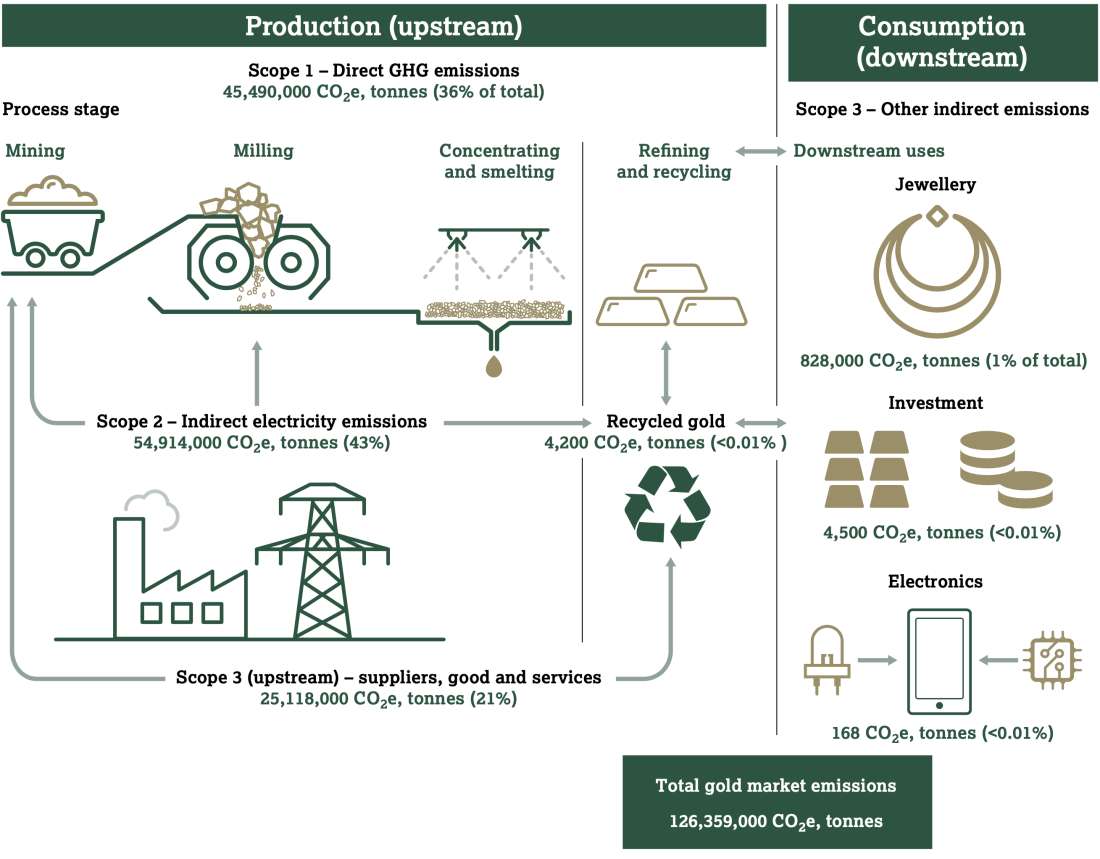
To compare this to Bitcoin’s electricity consumption, we only considered direct GHG emissions (scope 1), indirect electricity emissions (scope 2), and any emissions associated with gold refining and recycling. The annual GHG emissions from these segments amounted to 100,408,508 tCO2. We then converted the GHG emissions number to kWh/yr using a global IEA carbon intensity multiplier of 0.92 lb CO2/kWh16. This implies a conservative assumption that the gold industry aligns with the global average carbon intensity of other industries. Using this multiplier, we estimate that these elements of the gold industry utilize roughly 240.61 TWh/yr. These estimates may exclude key sources of energy use and emissions that are second order effects of the gold industry like the energy and carbon intensity of the tires
used in gold mines.
A report published in 2018 by Money Metals points out “even though a tire cost is listed as a material cost, the majority of a tire’s production cost comes from burning energy…in all forms and in all stages.” They report that Barrick Gold consumed 25,000 tons of tires in 2013. The Rubber Manufacturing Association reports that seven gallons of oil are required to produce a standard car tire. The tires used in gold mining operations are not an average, everyday car tire; these tires are used for operating large machinery and have a diameter as large as 13 feet and can weigh up to 11,860 pounds.

Auditing the Banking System’s Energy Usage
Note: Throughout this piece, we reference several in-depth calculations. The methodology and calculations can be found here.
The banking system is not perfectly comparable to Bitcoin. The retail and commercial banking system requires multiple settlement layers, while Bitcoin offers final settlement. As a near-analog, though, we estimate the legacy banking system’s energy consumption based on the assumptions below.
The banking industry does not directly report electricity consumption data. The four key areas of electricity consumption associated within the broader banking system with enough data to establish acceptable estimates are:
banking data centers,
bank branches,
ATMs,
and card network’s data centers.
The global electricity consumption of the banking system is estimated to be 238.92 TWh/yr.
Banking Data Centers
The banking system does not report electricity consumption data required to operate their data centers. Several assumptions were made to estimate this figure.
The only bank that reports the number of data center it uses is Bank of America, which has 23 private data centers. The demand, location, and area of these data centers are not reported. To obtain the electricity consumption of these data centers, an estimated area of 75,000 ft2 and a 400 W/ft2 of demand are assumed. A banking data center operates 24 hours a day, 7 days a week, 52 weeks a year, for a total of 8,760 hours per year. The annual electricity consumption is estimated to be 6.04 TWh/yr.
In order to estimate the data center demand for the top 100 global banks as reported by the S&P Capital IQ, a linear relationship between Bank of America’s estimated data center electricity consumption and the total deposits is assumed. The total deposits for the top 100 global banks are $70,972.10 billion, and the total deposits for Bank of America is $1,795.48 billion. The estimated annual electricity consumption of the banking system’s data centers
is estimated to be the product of the total top 100 global banks annual deposits and the ratio of Bank of America’s estimated annual data center usage to Bank of America’s annual deposits, which is 238.92 TWh/yr.
Bank Branches
The banking system does not report electricity consumption data required to operate bank branches. We estimate this figure by taking the product of the total number of bank branches, the average electricity consumption of a small business on a global scale, and the hours of operation. A bank branch is considered to operate 9 hours a day, 5 days a week, 50 weeks a year, for a total of 2,250 hours per year. A bank branch is considered to be a small
business.
The total number of bank branches is publicly available data. We estimate the average electricity consumption of a small business on a global scale to be an average of the small business electricity consumption of four countries on four different continents: the United States, United Kingdom, Mexico, and China. The small business electricity consumption for Mexico and China is not readily available, so we estimate it based on their residential data. More information on this calculation is included in the accompanying report.
We estimate the global annual electricity consumption of bank branches to be 19.71 TWh/yr.
This analysis s does not take into account the gas consumption of bank branches (i.e., heating) nor the electricity and gas consumption of all other financial office buildings.
Bank ATMs
The banking system does not report data on the electricity required to operate ATMs. We estimate this figure by taking the product of the total number of ATMs, the demand of a typical ATM, and the hours of operation. An ATM is operational 24 hours a day, 7 days a week, 52 weeks a year, for a total of 8,760 hours. The typical demand of an ATM is taken to be 145W.
We estimate the global annual electricity consumption of ATMs to be 3.09 TWh/yr.
Card Networks
Card networks do not report electricity consumption data required to operate their infrastructure. The only card network with some publicly available data on their data centers is VISA, which reports operating five data centers worldwide. While VISA does not report each data center’s electricity demand, they do disclose the square footage of each. Accordingly, we estimate the demand of VISA’s data centers based on their square footage. We use this demand, the number of transactions that VISA processed in 2019, and VISA’s market share by transaction count in 2019 to make the final electricity consumption estimate for all card networks. This assumes a linear relationship between transaction count and estimated data center electricity consumption.
On average, a data center demands up to 400 W/ft2. To estimate VISA’s electricity consumption, we multiply the total area of all of VISA’s data centers, their demand per square foot, and their hours of operation. VISA data centers are assumed to run 24 hours a day, 7 days a week, 365 days per year, for a total of 8,760 hours per year.
We estimate the electricity consumption of the VISA network to be 0.84 TWh/yr. In 2019, VISA processed 185.5 billion transactions of the total 441.0 billion transactions. We estimate the global annual electricity consumption required for all card networks to operate to be 2.00 TWh/yr.
This analysis does not take into account the electricity consumption for all card network’s office buildings.
Summary of the Banking System Energy Usage
Electricity data for the banking industry is scarce. With the publicly available information that we could find, we estimate the banking system uses 263.72 TWh of energy each year. Deriving a comprehensive number for this sector’s energy consumption would require individual banks to self-report.
Even in aggregate, a comparison between Bitcoin and the layers of the banking system is inherently flawed. The traditional financial stack is a complicated hierarchy of counterparties and intermediate settlement. Credit card networks are great for exchanging fast payments and IOUs, but they depend on the banking system for settlement, and the banking system in turn depends on central banks for final settlement, which in turn depends on the dollar
system as a whole.
In the interest of scope, we have excluded central banks, clearinghouses (like the DTCC), and other aspects of the traditional financial system from the above analysis. It is important to note that this audit is only a slice of the entire system—the overall energy usage of the banking system is unknown and externalities are excluded.
Defining the banking system’s utility by its energy usage is reductive—overlooking the benefits of transferring large quantities of money. While it may seem practical to compare the banking system and Bitcoin on the number of transactions they process, the two have different scaling properties. The banking system scales with transaction count, requiring additional infrastructure as it grows. Meanwhile, Bitcoin’s energy consumption scales not by
transaction count, but by network economics.
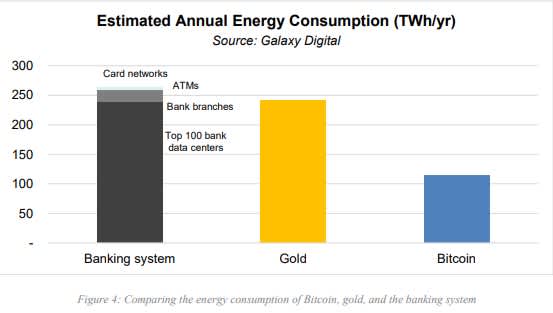
So What?
These statistics provide interesting context, but how do they help us answer the initial question: Is the Bitcoin network’s electricity consumption an acceptable use of energy?
Although we can estimate and compare the magnitude of different industries’ energy usage, the question is still fundamentally a value judgment. One’s answer depends on their beliefs about the utility of bitcoin.
Value is in the Eye of the Beholder
Value is subjective, and there is a wide spectrum of opinions around bitcoin’s utility.
Viewpoints on Bitcoin’s energy consumption range from wasteful to justified to anywhere in between. On one end, critics believe that bitcoin is merely a tool for speculation or illicit activity, attached to a network with an unjustifiable environmental cost. On the other, supporters view bitcoin as a monetary revolution that will be a boon to humanity.
We at Galaxy believe in Bitcoin and the broader ecosystem; we have built an entire company around it. That said, we understand that this is not a universally shared view.
Rather than attempt to preemptively characterize every possible perspective on Bitcoin, we instead consider 3 representative viewpoints along the spectrum:
Bitcoin will not be a part of the global economy. This group believes that no energy expenditure is acceptable.
Bitcoin will work in parallel with the current financial system (similar to gold). This group believes Bitcoin’s energy consumption is warranted, though markets and regulation will help determine the appropriate level. While members of this group believes that energy consumption is not inherently a bad thing, they still think it imperative to use energy in the most carbon-efficient way possible.
Bitcoin will be a global monetary standard. This group believes Bitcoin’s energy expenditure will be dictated by market demand.
Group 1: Bitcoin Will Not be a Part of the Global Economy
This group believes that no amount of energy consumption is justified because they believe bitcoin has no value. We at Galaxy Digital disagree, as Bitcoin is often used toward humanitarian ends.
Bitcoin is Not Just for the Rich Getting Richer
Citizens of developed nations often take stable financial infrastructure for granted. Despite recent aggressive monetary expansion, concerns about ATM withdrawals or government seizure of money are rare. But this is not the case for much of the world’s population.
Inflation ravages citizens of Zimbabwe, Venezuela, Myanmar, Argentina, and many other countries. Affected individuals are forced to find an alternative to cash.
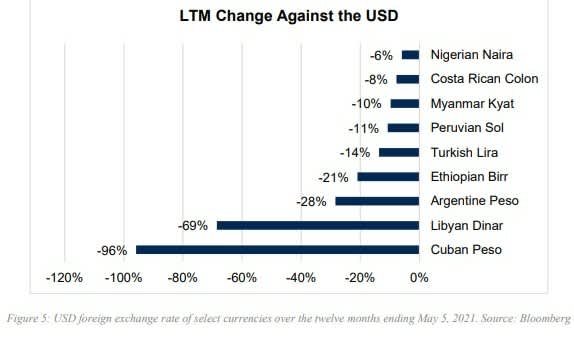
In affected countries, this trend is visible through increased trading volumes on peer-to-peer marketplaces like Paxful and LocalBitcoins.
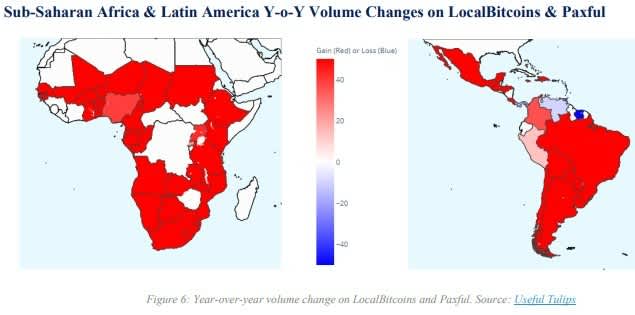
For these users, bitcoin is not a tool to get rich quick; it is a lifeboat to help preserve their family’s financial resources in the face of a rapidly depreciating currency.
Beyond wealth preservation, bitcoin helps citizens of oppressive countries access money. Alex Gladstein of the Human Rights Foundation points out “around 4.2 billion people live under authoritarian regimes that use money as a tool for surveillance and state control. Their currency is often debased, and they are, for the most part, cut off from the international [financial] system.” Gladstein goes on:
In the past few months, Belarusian activists have used bitcoin to defy the regime by sending more than 3 million dollars of unstoppable money directly to striking workers, who then convert it locally to rubles in peer-to-peer marketplaces to feed their families as they protest the country’s dictatorship.
In October, a feminist coalition in Nigeria raised the equivalent of tens of thousands of dollars in bitcoin to buy gas masks and protest equipment as activist bank accounts were being turned on and off.
In Russia, the opposition politician Alexei Navalny has raised millions in bitcoin as Vladimir Putin maintains strict control over the traditional financial system. Putin can do a lot of things, but he can’t freeze a Bitcoin account.
Even in developed countries, a subset of the population, the unbanked, is excluded from the traditional banking system. According to the 2019 FDIC annual report, there are 7.1 million unbanked households in the U.S. This group skews heavily toward “lower-income households, less-educated households, Black households, Hispanic households, American Indian or Alaska Native households, working-age disabled households, and households with volatile income.” When asked why they cannot access financial services, 48.9% of respondents replied that they did not have enough money to meet minimum bank requirements. This means nearly half of the unbanked population in the U.S.—fully 3.5 million households—cannot afford a bank account. For context, that number is roughly equal to all the households in the state of Connecticut.
Bitcoin offers a solution, allowing anyone, anywhere (with an internet connection) to store their value regardless of income or social-economic status. No account minimums required.

Group 2: Bitcoin Will Exist in Parallel with the Current Financial System
Members of this group believe that bitcoin will play some role in the global economy but may be worried about its energy usage. This viewpoint often overlooks the value Bitcoin mining offers the energy sector.
Bitcoin Mining as a Tool for the Energy Sector
Miners can operate anywhere with electricity and an internet connection. This benefits the energy sector by creating a perfect use case for intermittent and excess energy.
As of 2014, the World Bank estimates that 8.25% of electricity is lost in transmission. Applying this figure to the 2018 International Energy Agency (IEA) global electricity production estimate of 26,730.07 TWh/yr yields an annual global electricity transmission loss of 2,205.23 TWh/yr. This loss is 19.36 times as large as Bitcoin’s annual energy consumption. Though not all this lost energy could be used for Bitcoin mining, it highlights both the current amount of energy lost each year due to inefficiency as well as the fact that energy is not fungible.
Critics often assume that the energy expended by miners is either stolen from more productive use cases, or results in increased energy consumption. But because of inefficiencies in the energy market, bitcoin miners are incentivized to utilize nonrival energy that may otherwise be wasted or underutilized, as this electricity tends to be the cheapest.
Though the revenue associated with mining varies, miners have the luxury of flexibility, with the option to switch their equipment on or off at any time. This makes Bitcoin mining the ideal energy sink: anyone, anywhere, can monetize excess energy by plugging in equipment and switching it off at their convenience.
Bitcoin Mining & Flare Mitigation
One example of where Bitcoin mining acts as an energy sink is in oil fields, resulting in a direct reduction in methane emissions. According to the IEA, oil accounts for nearly 40% of the current global energy supply. Oil wells are abundant throughout many regions in the world, as energy companies seek to extract the resource for refinement.
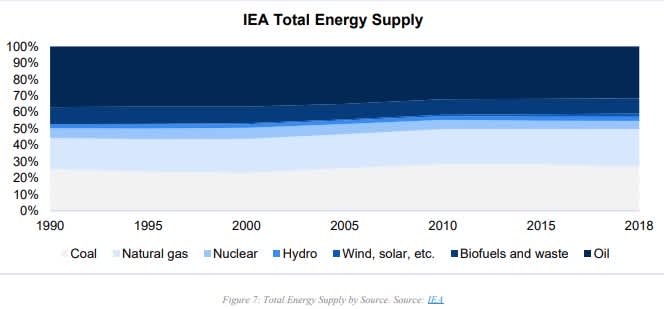
A frequent byproduct of the oil extraction process is methane. Though methane is also a functional fuel, it cannot be transported without a pipeline. As a result, the methane is typically either vented (let out into the atmosphere) or flared (lit on fire) at the wellhead. Neither procedure is ideal.
The greenhouse effects associated with methane are 25 times as environmentally damaging as those of an equivalent quantity of CO2. Flaring burns the methane and produces CO2 as a byproduct, theoretically reducing the CO2 equivalents by 24x. That said, the efficiency of flaring varies substantially, and in some cases can be as low as 30%—meaning even if the methane is flared, up to 70% can still escape into the atmosphere.
Bitcoin mining offers a solution. Companies like Great American Mining, Upstream Data, and Crusoe Energy Systems are building infrastructure to capture this methane at the wellhead and use the otherwise-wasted gas to mine bitcoin. Unlike flaring, generators can burn this methane with 99% efficiency, vastly reducing the risk of leakage into the atmosphere. This means that oil producers can ensure a 24x reduction in emissions compared to venting that methane into the atmosphere. The IEA estimates that the oil and gas sector emitted 82 Mt (around 2.5 GtCO2-eq) in 2019. For context, this equivalent to roughly 8% of the 33.2 Gt of the global energy-related CO2 emissions that year.
Another example of the opportunity for Bitcoin mining utilizing excess energy can be seen in the curtailment of wind and solar generation.
Bitcoin & Intermittent Energy
The intermittent generation of wind and solar resources is typically offset by flexible generation elsewhere (e.g., natural gas). There is more wind and solar generation than can be offset, leading to curtailment.
While the exact amount of energy curtailed every year is hard to pinpoint, various estimates suggest it would constitute a meaningful portion of the Bitcoin network. One recent study estimates that solar generation in Chile, China, Germany, and key regions in the U.S. curtailed 6.5 TWh in 2018, while another study estimates 21.5 TWh suggest that 57 TWh of wind and solar generation was curtailed in China alone in 2016.
As an energy sink, Bitcoin mining could help monetize this energy at the site of generation or smooth out volatility at the grid level.
Mining in oil fields and utilizing excess wasted energy are two examples of the network’s ability to leverage excess and intermittent energy. Others include capturing excess electricity from hydroelectric dams and helping powerplants operate at optimal efficiency.
Group 3: Bitcoin Will Become the Global Monetary Standard
For this camp, energy utilization is directly proportional to network security. The network will only consume as much energy as the market demands because miners are economically rational.
Power Usage is a Feature, Not a Bug
Under Bitcoin’s PoW consensus mechanism, increased energy usage is directly related to increased robustness and security. As hash rate grows, threats of both centralization and 51% attacks become less realistic.
The threat of geographic centralization is waning. In North America alone, public mining companies have announced an expansion of roughly 40 exahashes to be deployed by the end of 2021, representing a 28% increase in the current network hash rate.
Because the network is growing, the likelihood of a successful attack is always decreasing. At the time of writing, a successful 51% attack would require control of more than 8GW of existing mining capacity, or 16GW of new mining machines. Considering the cost of the electricity required to operate these machines, an attack would be an enormous undertaking. And the target is not static; by the time a meaningful portion of this capacity could be amassed, the network hash rate would have already increased.
The Bitcoin Miner: A Rational Actor
Miners are first and foremost economically motivated actors. As discussed in our Fundamentals of Bitcoin Mining Economics post, Bitcoin miners actively seek low-cost electricity in order to maximize profit. Because all miners on the network are in competition with each other, they are all incentivized to minimize their operating costs and position themselves on the low end of the cost curve (even if this means migrating from one energy rich region to another). This means that miners will seek energy sources with the lowest marginal cost.
Even if miners are bullish on bitcoin, they will only choose to invest into a mining operation with the expectation of profit. Conversely, an unprofitable miner will spin down their operation when needed. For example, after the most recent halving in May 2020, network hash rate dropped 23% due to decreased revenue. Miners with efficient operations remained profitable and benefited from decreased competition.
Conclusion
This report took a quantitative approach, comparing Bitcoin’s energy usage to that of other industries. In the interest of an honest conversation, we also discussed why the value of Bitcoin is not just quantitative.
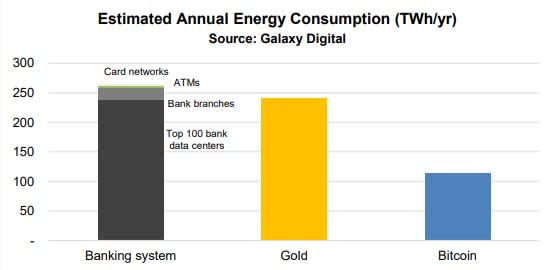
Subjective views on the Bitcoin network’s importance vary, but Bitcoin’s properties do not. Anyone can use Bitcoin. Anyone can hold bitcoins for themselves. And Bitcoin transactions can provide probabilistically final settlement in an hour, 24 hours a day, 365 days per year.
These features can offer financial freedom to people around the world without the luxury of stable and accessible financial infrastructure. The network can benefit the energy sector by creating perfect use cases for intermittent and excess energy. And the network will only scale further if network adoption warrants it.
Energy utilization is not necessarily a bad thing. As Smil writes, energy is the only universal currency. Humans will continue to find new technologies that require more energy that challenge the status quo. Bitcoin is yet another example.
So, if we return one last time to the original question: Is the Bitcoin network’s electricity consumption an acceptable use of energy? Our answer is definitive: yes.
Legal Disclosure:
This document, and the information contained herein, has been provided to you by Galaxy Digital Holdings LP and its affiliates (“Galaxy Digital”) solely for informational purposes. This document may not be reproduced or redistributed in whole or in part, in any format, without the express written approval of Galaxy Digital. Neither the information, nor any opinion contained in this document, constitutes an offer to buy or sell, or a solicitation of an offer to buy or sell, any advisory services, securities, futures, options or other financial instruments or to participate in any advisory services or trading strategy. Nothing contained in this document constitutes investment, legal or tax advice or is an endorsement of any of the stablecoins mentioned herein. You should make your own investigations and evaluations of the information herein. Any decisions based on information contained in this document are the sole responsibility of the reader. Certain statements in this document reflect Galaxy Digital’s views, estimates, opinions or predictions (which may be based on proprietary models and assumptions, including, in particular, Galaxy Digital’s views on the current and future market for certain digital assets), and there is no guarantee that these views, estimates, opinions or predictions are currently accurate or that they will be ultimately realized. To the extent these assumptions or models are not correct or circumstances change, the actual performance may vary substantially from, and be less than, the estimates included herein. None of Galaxy Digital nor any of its affiliates, shareholders, partners, members, directors, officers, management, employees or representatives makes any representation or warranty, express or implied, as to the accuracy or completeness of any of the information or any other information (whether communicated in written or oral form) transmitted or made available to you. Each of the aforementioned parties expressly disclaims any and all liability relating to or resulting from the use of this information. Certain information contained herein (including financial information) has been obtained from published and non-published sources. Such information has not been independently verified by Galaxy Digital and, Galaxy Digital, does not assume responsibility for the accuracy of such information. Affiliates of Galaxy Digital may have owned or may own investments in some of the digital assets and protocols discussed in this document. Except where otherwise indicated, the information in this document is based on matters as they exist as of the date of preparation and not as of any future date, and will not be updated or otherwise revised to reflect information that subsequently becomes available, or circumstances existing or changes occurring after the date hereof. This document provides links to other Websites that we think might be of interest to you. Please note that when you click on one of these links, you may be moving to a provider’s website that is not associated with Galaxy Digital. These linked sites and their providers are not controlled by us, and we are not responsible for the contents or the proper operation of any linked site. The inclusion of any link does not imply our endorsement or our adoption of the statements therein. We encourage you to read the terms of use and privacy statements of these linked sites as their policies may differ from ours. The foregoing does not constitute a “research report” as defined by FINRA Rule 2241 or a “debt research report” as defined by FINRA Rule 2242 and was not prepared by Galaxy Digital Partners LLC. For all inquiries, please email [email protected]. ©Copyright Galaxy Digital Holdings LP 2022. All rights reserved.




